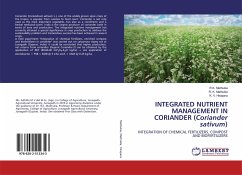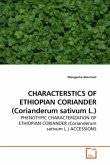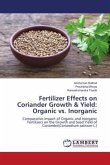Coriander (Coriandrum sativum L.), one of the widely grown spice crops of the tropics, is popular from cuisines to food court. Coriander is not only used as the most important vegetable, but also as a condiment and a herbal medicinal plant. India is the largest producer of coriander both in terms of area and production. The integrated nutrient management has currently attained a special significance in crop production to address the sustainability problem and tremendous success has been achieved in several crops.A field experiment "Integration of chemical fertilizers, enriched compost and biofertilizers in coriander" was carried out on calcareous clayey soil at Junagadh (Gujarat, India). It could be concluded that higher production, net returns from coriander (Gujarat Coriander-2) can be obtained by the application of RDF (60-60-40 N-P2O5-K2O kg/ha) + soil application of Azotobacter + PSB + KMB @ 3 L/ha each + VAM @ 0.25 kg/ha.








